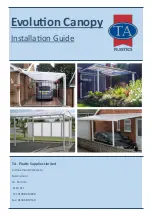
5
With the door closed, peg down the
flysheet starting at the corners and
either side of the doorway before then
pegging down the
intermediate
pegging points. Re-adjustment of
previous pegging may need to be
done here.
9
10
Doorways and entrances should be cross pegged – the points should be pulled
across each other. Once completed the tent should look taut without too many
creases – if necessary readjust the pegging. A well pitched tent will tolerate bad
weather much better than one that is poorly erected.
PEGS
The tent comes complete with general purpose wire pegs. These will be
suitable for many sites but there will be some instances where different pegs will
be necessary. Your dealer will stock a range of pegs suitable for different types
of ground. For maximum effectiveness, pegs
should be driven into the ground at a 45°angle
away from the pegging point.
GUY ROPES
The tent comes with guy lines pre-attached. We
recommend that these guy lines are used at all
times. Peg the guy lines so that the tent is under
tension without distorting the shape. The guy
lines can be adjusted using the runners. Guy
lines should be secured using suitable pegs (see
above) and the guy line should generally be
pegged in line with the seam of the tent it starts
from. Check the guy lines from time to time to
ensure that they are still adequately tensioned.
Attach the metal pins at the base of
the pole sleeves to the poles.
6
RAIN
We make our tents as resistant to the weather as possible. Occasionally you
may find slight leakage. This is not a fault with the manufacturing process or
materials and can normally be rectified by spot treating the seam with seam
sealant (see below).
SEAMS
The main seams of this tent have been factory taped to help prevent leakage.
Depending upon your expectations, it may be necessary to treat the remaining
seams with a seam sealant. Seam sealant should also be applied to areas
where the taping is damaged or has peeled away through wear and tear. It can
also be applied to areas where a leak may have developed. Kampa Seam Seal-
ant is available through your dealer.
SUITABILITY
This tent is designed for use in light to moderate weather. During very strong
winds or snowfall we recommend that you take your tent down. The tent is de-
signed for occasional use; it is not designed for static or commercial use.
UV DEGRADATION
Tent fabrics can be weakened by prolonged exposure to sunlight. Under normal
holiday use your tent will give long service but use for extended periods in strong
sunlight will soon cause deterioration. In those cases it would be wise to use a
site as shaded as possible. UV degradation is not covered under the warranty.
The warranty does not cover tents used on permanent sites, displays or for com-
mercial purposes.
CONDENSATION
Tents contain a high proportion of synthetic materials and under certain
conditions will be effected by condensation inside the tent. This should
not be confused with leaking. Condensation can be improved by ensuring
adequate ventilation. The tent comes with various ventilation ports that
can be opened and it may also help to keep a door open when the weather
allows. Condensation and its effects are not covered under the warranty.
SAFETY
DO NOT COOK IN THE TENT OR USE NAKED FLAMES. READ AND UN-
DERSTAND THE FIRE PRECAUTIONS LABEL SEWN INTO THE INSIDE OF
THE TENT.
DISMANTLING
Reverse the set up procedure. Push the poles out of the sleeves, do not pull.
Ensure that all parts are clean before packing in the carry bag. If the tent is wet
or damp, dry fully as soon as possible.






















